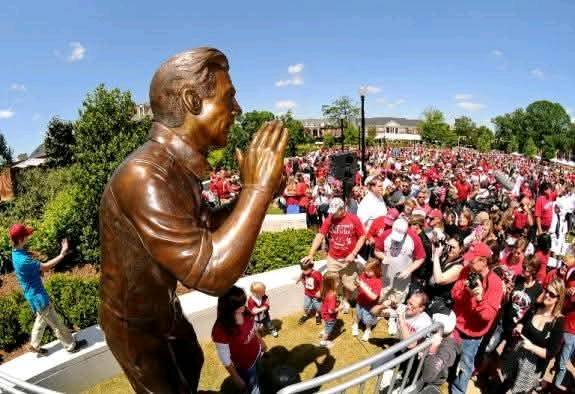Casting a shadow as profound and enduring as the Crimson Tide itself, the University of Alabama has unveiled a monumental tribute, a life-size bronze statue of Nick Saban, forever immortalizing the coaching titan whose name has become synonymous with unparalleled success. This isn’t merely a piece of art; it’s a “Statue of Honor,” a tangible manifestation of a legacy so grand it demands a physical representation of its magnitude. Crafted with meticulous care by “Bama Management,” a phrase that evokes the very fabric of the university’s institutional memory and collective pride, this sculpture stands as a testament to the man who didn’t just win football games, but fundamentally reshaped an entire athletic program and, in doing so, an entire community’s identity. The unveiling wasn’t just an event; it was a pilgrimage, a moment of profound reverence for the architect of modern Alabama football, a fitting capstone to a career that will echo through the annals of sports history.
The decision to commission such a significant piece was not a matter of if, but when. From the moment Nick Saban arrived in Tuscaloosa in 2007, an almost palpable shift occurred. The program, steeped in glorious tradition but having endured a period of relative dormancy, awoke with a ferocity rarely seen. What followed was an unprecedented era of dominance, a dynasty forged in relentless preparation, strategic brilliance, and an unwavering commitment to a process that became legendary. Six national championships, nine SEC championships, and an astounding 206 victories against only 29 losses – these are not just statistics; they are the bedrock upon which Saban’s legacy is built. The statue, therefore, is not just for Nick Saban, the man; it is for everything he represents: the championships, the Heisman Trophy winners, the All-Americans, the NFL draft picks, and, perhaps most importantly, the profound sense of pride and unity he instilled in the Crimson Tide faithful.
The creation of the statue itself is a story of dedication mirroring Saban’s own. “Bama Management,” a term that encompasses the collaborative effort of the university’s administration, athletic department, and a carefully selected artistic team, undertook the immense responsibility of translating a living legend into a timeless bronze form. The challenge was immense: how to capture the essence of a man known for his intensity, his strategic mind, and his often stoic demeanor, while also conveying the deep respect and admiration he commands. The artist chosen for this monumental task faced the unenviable position of satisfying not just the university, but an entire fanbase with an almost familial connection to their coach. The process involved countless hours of studying photographs, videos, and even subtle gestures, ensuring that every detail, from the set of his jaw to the slight furrow of his brow, authentically reflected the man millions had come to know and revere. The life-size aspect was crucial, allowing for an intimate connection, making visitors feel as though they are standing in the presence of the legendary coach himself, perhaps even receiving one of his famously direct assessments.
The location of the statue was undoubtedly a point of careful consideration, ultimately settling on a spot of prominence that ensures Saban’s perpetual presence and influence over the program he built. Perhaps it is strategically placed near Bryant-Denny Stadium, a silent sentinel overseeing future generations of Crimson Tide players and coaches, a constant reminder of the standard that was set. Or perhaps it stands at the entrance to the Mal M. Moore Athletic Facility, where the “Process” was meticulously crafted and perfected, inspiring those who now walk the halls to strive for the same level of excellence. Wherever it is placed, its positioning is symbolic, ensuring that Saban’s spirit of unwavering commitment and pursuit of perfection continues to imbue every aspect of Alabama football.
The unveiling ceremony itself was an event charged with emotion and reverence. University dignitaries, former players, current coaching staff, and, of course, the loyal Crimson Tide fanbase converged to witness history unfold. Speeches undoubtedly lauded Saban’s unparalleled achievements, highlighted personal anecdotes, and celebrated the indelible mark he left on their lives and on the sport. The atmosphere would have been one of profound gratitude, a collective acknowledgment of a man who gave so much to the university and its community. Nick Saban, in his typical humble fashion, would likely have deflected much of the praise, crediting his players, his staff, and the unwavering support of the fanbase. Yet, even he, in that moment, must have felt the weight of the immense appreciation emanating from the crowd, a tangible realization of the extraordinary legacy he cultivated.
Beyond the championships and the accolades, the statue represents something deeper: the enduring impact of Nick Saban on the lives of countless young men. His “Process” wasn’t just about winning football games; it was about instilling discipline, fostering accountability, and developing young athletes into responsible adults. Many former players have spoken eloquently about how Saban’s demanding yet ultimately transformative leadership shaped their character and prepared them for success not just on the field, but in life beyond football. The statue, therefore, also serves as a silent acknowledgment of these countless individual journeys, each one touched by the unwavering hand of Coach Saban. It’s a tribute not just to the victories, but to the virtuous cycle of development he championed, where hard work and dedication led to both athletic triumph and personal growth.
In the grand tapestry of college football, few figures cast a shadow as long and as impactful as Nick Saban. He built a dynasty, not just through sheer talent acquisition, but through an almost obsessive pursuit of perfection in every facet of the program. The statue, cast in enduring bronze, perfectly encapsulates this unwavering dedication. It is a monument to a coaching philosophy that prioritized precision, preparation, and an unyielding commitment to the highest standards. It serves as a visual mnemonic, a reminder that true greatness is forged not just in moments of glory, but in the relentless, often unglamorous, pursuit of excellence day in and day out.
This “Statue of Honor” is more than just a likeness; it is a symbol. It symbolizes an era of unprecedented achievement, a golden age for Alabama football that will be recounted for generations. It symbolizes the power of vision, leadership, and an unwavering commitment to a process. It symbolizes the deep and abiding connection between a coach, a university, and its passionate fanbase. As visitors gaze upon the life-size bronze figure of Nick Saban, they will not just see a statue; they will see the embodiment of a legend, a testament to a legacy that will forever be woven into the fabric of the University of Alabama, a constant inspiration and a timeless reminder of what true greatness looks like. The crafting of this statue by “Bama Management” is not merely an artistic endeavor; it is an act of preserving history, ensuring that the saga of Nick Saban and the Crimson Tide’s unparalleled dominance remains vivid and vital for eternity.



